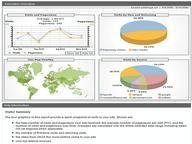Quiz Answer Key and Fun Facts
1. In combinatorial analysis, the basic principle of counting provides a convenient way to calculate the number of possible outcomes for experiments. Let say you are given 3 caps, 4 shirts, 5 pants and 6 pairs of shoes. By using this principle, how many ways can you dress yourself?
2. Let say there are 8 contestants in a contest. There are 8P3 = 336 possible combinations for the top three spots. Here, the letter "P" stands for permutation. Which of the following formula is equivalent to nPr?
3. You are given 10 balls and you are to choose 3 balls from these 10 balls. So, you have 10C3 = 120 ways to choose it. Here, the letter "C" represents "combination". Is it true that nCr = nC(n-r)?
4. The binomial theorem provides a convenient way to calculate the value of the coefficients for all the terms in any expansion involving 2 unknowns. The values of these coefficients can also be obtained from which famous mathematical figures?
5. Set operations are used extensively in the study of probability theory. Let A, B and C be any 3 events and S is the sample space. Choose the WRONG matching pair from the list below.
6. In general, there are 4 definitions for probability. Which one of these 4 definitions is the one that is used as the fundamental and formal definition in the study of probability theory?
7. A conditional probability is represented by P(A|B). How do we interpret this probability?
8. Let say 2 events satisfy the following equation: P(A intersect B) = P(A) x P(B). We say that events A and B are ___.
9. If events A and B are independent, will events A' and B' be independent as well?
10. There are 3 boxes, A, B and C. The probability of choosing box A, B and C are 0.5, 0.3 and 0.2 respectively. Box A, B and C contains 20%, 30% and 50% rotten apples. What is the probability that an apple is drawn from box A given that it is rotten? To solve this kind of problem, what theorem should we use?
Source: Author
Matthew_07
This quiz was reviewed by FunTrivia editor
crisw before going online.
Any errors found in FunTrivia content are routinely corrected through our feedback system.


